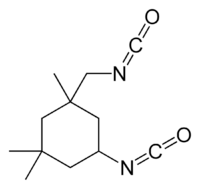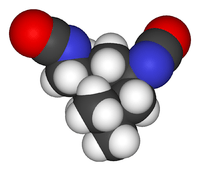Isophorone diisocyanate
 | |
 | |
| Names | |
|---|---|
| IUPAC names
5-isocyanato-1- (isocyanatomethyl)- 1,3,3-trimethyl-cyclohexane | |
| Other names
IPDI | |
| Identifiers | |
| 4098-71-9 | |
| 3D model (Jmol) | Interactive image |
| ChEBI | CHEBI:53214 |
| ChemSpider | 147926 |
| ECHA InfoCard | 100.021.692 |
| PubChem | 169132 |
| |
| |
| Properties | |
| C12H18N2O2 | |
| Molar mass | 222.3 g/mol |
| Appearance | Colourless to slightly yellow liquid[1] |
| Odor | pungent[1] |
| Density | 1.062 g/cm3 @ 20 °C, liquid |
| Melting point | −60 °C (−76 °F; 213 K) |
| Boiling point | 158 °C (316 °F; 431 K) at 1.33 kPa |
| Vapor pressure | 0.0003 mmHg (20°C)[1] |
| Hazards | |
| Flash point | 155 °C (311 °F; 428 K) (PMCC) |
| US health exposure limits (NIOSH): | |
| PEL (Permissible) |
none[1] |
| REL (Recommended) |
TWA 0.005 ppm (0.045 mg/m3) ST 0.02 ppm (0.180 mg/m3) [skin][1] |
| IDLH (Immediate danger) |
N.D.[1] |
| Related compounds | |
| Related isocyanates |
Hexamethylene diisocyanate |
| Except where otherwise noted, data are given for materials in their standard state (at 25 °C [77 °F], 100 kPa). | |
| | |
| Infobox references | |
Isophorone diisocyanate (IPDI) is an organic compound in the class known as isocyanates. More specifically, it is an aliphatic diisocyanate. It is produced in relatively small quantities, accounting for (with hexamethylene diisocyanate) only 3.4% of the global diisocyanate market in the year 2000.[2] Aliphatic diisocyanates are used, not in the production of polyurethane foam, but in special applications, such as enamel coatings which are resistant to abrasion and degradation from ultraviolet light. These properties are particularly desirable in, for instance, the exterior paint applied to aircraft.
Synthesis
There are five steps to the synthesis of pure IPDI:[2]
- Condensation: Conversion of acetone with a catalyst to produce isophorone
- Hydrocyanation: Reaction of the isophorone with hydrogen cyanide to form isophorone nitrile
- Reductive amination: Reaction of the isophorone nitrile with ammonia, hydrogen and a catalyst, to form a mixture of isophorone diamine conformers (25/75 cis/trans)
- Phosgenation: Reaction of the isophorone diamine with phosgene to form a crude mixture containing IPDI conformers (25/75 cis/trans)
- Purification: Distillation of the crude IPDI to extract pure IPDI
Chemistry
IPDI exists in two stereoisomers, cis and trans. Their reactivities are similar. Each stereoisomer is an unsymmetrical molecule, and thus has isocyanate groups with different reactivities. The primary isocyanate group is more reactive than the secondary isocyanate group.[2]
See also
References
- 1 2 3 4 5 6 "NIOSH Pocket Guide to Chemical Hazards #0356". National Institute for Occupational Safety and Health (NIOSH).
- 1 2 3 Randall, David; Lee, Steve (2002). The Polyurethanes Book. New York: Wiley. ISBN 0-470-85041-8.
External links
- NIOSH Safety and Health Topic: Isocyanates, from the website of the National Institute for Occupational Safety and Health (NIOSH)
- Isophorone diisocyanate - NIOSH Pocket Guide to Chemical Hazards
